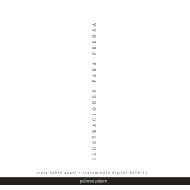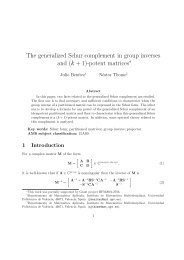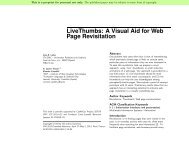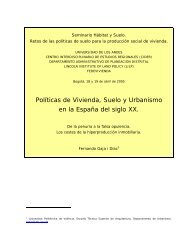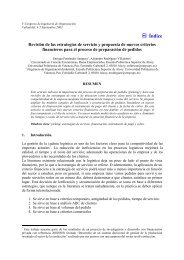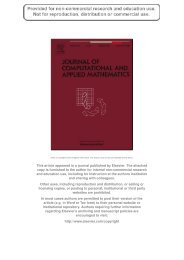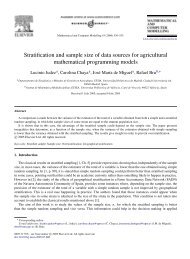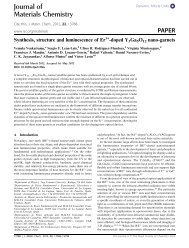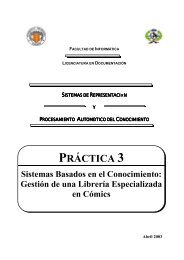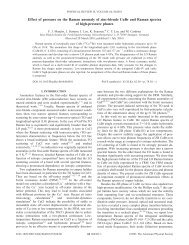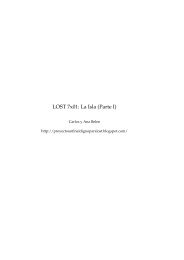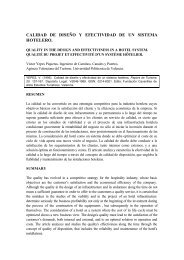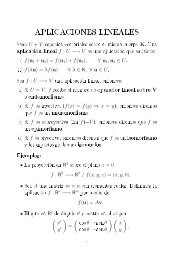The architectural morphology of corbelled dome houses
The architectural morphology of corbelled dome houses
The architectural morphology of corbelled dome houses
Create successful ePaper yourself
Turn your PDF publications into a flip-book with our unique Google optimized e-Paper software.
274<br />
Earthen Domes and Habitats<br />
Figs. 16a-d: Main types <strong>of</strong> <strong>dome</strong>s in the Syrian vernacular landscape:<br />
Simple <strong>dome</strong>, Sultan <strong>dome</strong>, Transition <strong>dome</strong>, Flat-ro<strong>of</strong> <strong>dome</strong><br />
Terrace, ‘Mastaba’<br />
<strong>The</strong> terrace is made <strong>of</strong> stones and earthen mortar, covered with a layer <strong>of</strong><br />
earth and straw. It is sheltered from the wind and used for drying fruit and<br />
vegetables. On hot summer nights it becomes a sleeping place, when the<br />
outside temperature is cooler than the house as it releases the heat collected<br />
during the day.<br />
Stables, ‘Hazera’ or ‘Qabu’<br />
In the Bedouin culture livestock has always been a valuable asset, though<br />
cattle were more numerous in the past than today. A space was designated<br />
for cattle away from the main habitation, in a tent or inside a perimeter wall<br />
with a woollen cover. Over the years, with the reduction <strong>of</strong> herds, animal<br />
enclosures have moved into the courtyard <strong>of</strong> the house. <strong>The</strong> facilities are<br />
very rudimentary, consisting <strong>of</strong> a simple wall in stone and earth to prevent<br />
the sheep escaping. In some cases a specific building, a flat ro<strong>of</strong> or <strong>dome</strong>, is<br />
reserved for the shelter <strong>of</strong> the livestock. Chickens and hens shelter in small<br />
cob <strong>dome</strong>s located in the courtyard, and during the day they are allowed to<br />
roam free around the territory <strong>of</strong> the house.<br />
Stores<br />
Rooms used for storage <strong>of</strong> objects are numerous and varied, under <strong>dome</strong>s <strong>of</strong><br />
the same type used for housing, or smaller cob <strong>dome</strong>s (qubbia). Sometimes<br />
even flat-ro<strong>of</strong> buildings are used for this purpose. <strong>The</strong> <strong>dome</strong>s, which are used<br />
to store straw (matban), possess a hole (af’a) at the top <strong>of</strong> the cover. <strong>The</strong><br />
aperture allows easy access to the straw compartment, and is closed with<br />
earthen mortar when the space is filled. <strong>The</strong> openings in these environments<br />
are generally oriented towards west, essential for the ventilation <strong>of</strong> the enclosure<br />
and to reduce infestation by insects.<br />
A classification <strong>of</strong> <strong>corbelled</strong> <strong>dome</strong> <strong>houses</strong><br />
<strong>The</strong> repertoire <strong>of</strong> <strong>dome</strong> structures, while based on a single constructional<br />
model, i.e. the <strong>dome</strong> raised by overhanging bricks, is found in a wide variety<br />
<strong>of</strong> types and variations. It is to be noted that the typology <strong>of</strong> construction<br />
adopted is closely linked to the available resources and materials <strong>of</strong> the site,<br />
and the original model is adapted to cater for specific housing needs.<br />
From the variety <strong>of</strong> <strong>dome</strong>s observed, we can identify certain recurring types,<br />
which differ from one another in formal aspects and constructional character<br />
(Fig. 16a-d). In the description <strong>of</strong> each type the formal-aesthetic characters<br />
and their relation to constructional aspects are highlighted.<br />
Despite the <strong>dome</strong>’s imposing character on the shape <strong>of</strong> the building, independent<br />
<strong>of</strong> the <strong>architectural</strong> variants to be shown in this text, the layout<br />
<strong>of</strong> the cell unit is always square, which aids in grouping units together. <strong>The</strong><br />
measurements may vary from one village to another, but uniform inside the<br />
Hama<br />
Simple Dome<br />
Alep<br />
Fig. 17: Map <strong>of</strong> distribution <strong>of</strong> types <strong>of</strong> <strong>dome</strong>s in northen Syria area<br />
Transition Dome<br />
Sultan Dome<br />
Flat Ro<strong>of</strong> Dome



